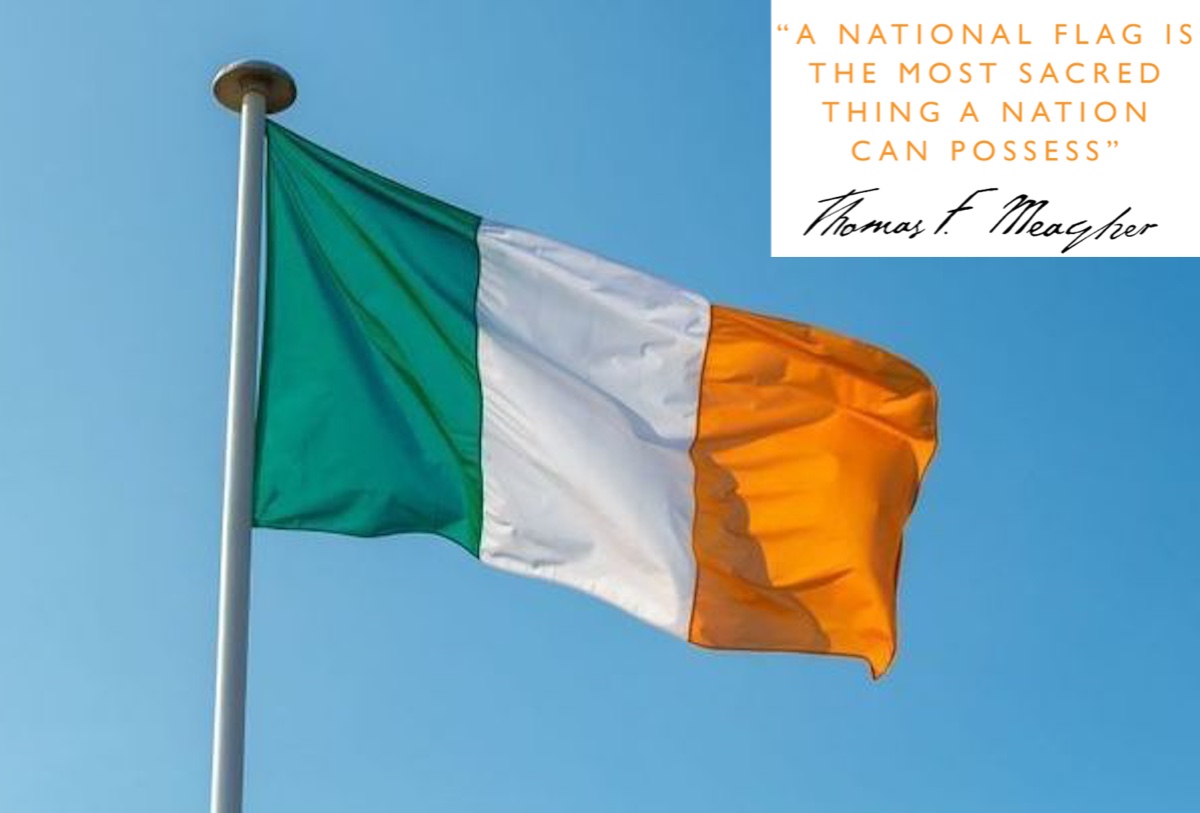
The National Flag of Ireland, often referred to as the tricolour, was first flown 175 years ago this week.
The Irish national flag is a flag of union. Its origin is to be sought in the history of the early nineteenth century and it is emblematic of the fusion of the older elements, represented by the green, with the newer elements, represented by the orange.
The combination of both colours in the tricolour, with the white between in token of brotherhood, symbolises the union of the different stocks in a common nationality.
A green flag with harp was an older symbol used by Irish nationalists, going back at least to Confederate Ireland and Owen Roe O’Neill in the 1640s. It was also widely adopted by the Irish Volunteers in the 1780s and especially by the United Irishmen in the 1798 rebellion.
A rival organisation, the Orange Order, which was exclusively Protestant, was founded in 1795 in memory of King William of Orange and the ‘Glorious Revolution’ of 1689. Following the 1798 Rebellion, the ideal of a later Nationalist generation in the mid-nineteenth century was to make peace between them and, if possible, to found a self-governing Ireland on such peace and union.
Irish tricolours were mentioned in 1830 and 1844, but widespread recognition was not accorded to the flag until 1848. From March of that year, Irish tricolours appeared side by side with French ones at meetings held all over the country to celebrate the revolution that had just taken place in France. On 7 March 1848, Thomas Francis Meagher, the Young Ireland leader, flew a tricolour from 33 The Mall in Waterford, where it flew continuously for a week until removed by the authorities. On the same day, a tricolour was reported to have been carried in a parade to Vinegar Hill, Enniscorthy, Co Wexford. In April, Meagher brought a tricolour from Paris, presented it to a Dublin meeting and outlined the significance of the colours:
“The white in the centre signifies a lasting truce between Orange and Green and I trust that beneath its folds the hands of Irish Protestants and Irish Catholics may be clasped in generous and heroic brotherhood.”
John Mitchel, also a member of the Young Ireland Movement, said: “I hope to see that flag one day waving as our national banner.”
Although the tricolour was not forgotten as a symbol of hoped-for union and a banner associated with the Young Irelanders and revolution, it was little used between 1848 and 1916. Even up to the eve of the Rising in 1916, the green flag with harp held undisputed sway.
The arrangement of the early tricolours was not standardised. All of the 1848 tricolours showed green, white and orange, but orange was sometimes put next to the staff, and in at least one flag the order was orange, green and white. In 1850 a flag of green for the Catholics, orange for the Protestants of the Established Church and blue for the Presbyterians was proposed. In 1883 a Parnellite tricolour of yellow, white and green, arranged horizontally, is recorded.
Down to modern times yellow or gold has occasionally been used instead of orange, but this substitution destroys the symbolism of the National Flag.
The Irish Tricolour flag was flown over the General Post Office on Easter Monday, 1916, along with a large green flag inscribed with the words “Irish Republic”. The Citizen Army Flag flew on the Imperial Hotel on O’Connell St. during the Rising. This flag shows a stylised representation of a plough with a representation of the constellation Ursa Major superimposed on it, all on a green field bordered by a gilt fringe.
Capturing the national imagination as the banner of the new revolutionary Ireland, the tricolour came to be accepted as the National Flag. It continued to be used officially during the period 1922-1937, and in the latter year its position as the National Flag was formally confirmed by the 1937 Constitution, Article 7 of which states: “The national flag is the tricolour of green, white and orange.”
![[Irish Republican News]](https://republican-news.org/graphics/title_gifs/rn.gif)
![[Irish Republican News]](https://republican-news.org/graphics/title_gifs/harp.gif)

